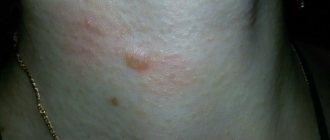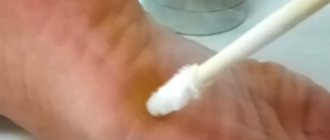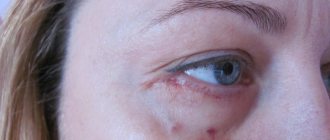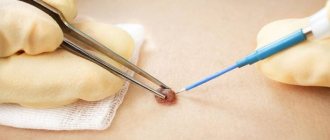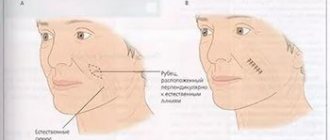pharmachologic effect
The drug is highly active and is a macromolecular complex of the proteolytic enzyme hyaluronidase. When taken, it has the following effects:
- relieves inflammation;
- eliminates swelling;
- promotes activation of humoral immunity;
- antifibrotic.
Longidaza improves tissue nutrition, eliminates adhesions, contractures, accelerates the resorption of bruises and hematomas, and also increases joint mobility.
The drug works best in the initial stages of the disease, preventing its progression and the development of complications.
Longidaza also enhances the effect of local anesthetics, increasing their bioavailability.
The medication is characterized by incredibly low toxicity and the absence of negative effects on the body.
Literature
- Injection methods in cosmetology / ed. B. Asher; lane from English; Ed. N.P. Mikhailova - M: MEDpress-inform, 2016. - 584 p.
- Ilsheva T.V. Complications of injection methods of correction in aesthetic medicine // Metamorphoses. – 2013. – No. 2. – P. 48–52.
- Ozerskaya O.S. Skin scars and their dermatocosmetological correction. – St. Petersburg: OJSC “Art of Russia”, 2007. – 224 p.
- Butov S.N., Akhtyamov Yu.S. Practical dermatocosmetology. - M.: Medicine, 2003. - 397 p.
- Privalova E.G., Gubanova E.I., Vasiliev A.Yu., Davydov D.V. The role of high-resolution ultrasound in the diagnosis of complications of facial contouring // Metamorphoses. - 2022. - No. 17.
- Karpyuk V.B. The state of nitrooxydergic vasorelaxation in subarachnoid hemorrhage (clinical and pathogenetic aspects of cerebral vasospasm): abstract. dis. ...cand. honey. Sci. – M., 2001. – 29 p.
- Bondarenko I.N. Clinical, pathogenetic and prognostic significance of nitric oxide in leptospirosis: dis. ...cand. honey. Sci. – Krasnodar, 2008. – 129 p.
- Karpova E.I. Compression-ischemic syndrome in the practice of a cosmetologist // Metamorphoses. -2014. - No. 5 - P. 54-58.
- Mingazova L.R., Karpova E.I., Orlova O.R., Kotenko K.V., Kruglova L.S. Complications in the form of neuropathic disorders in the facial area after contour injection plastic surgery // Russian Journal of Skin and Venereal Diseases. – 2014. – No. 3 – P. 52-55.
- Korenevskaya I.Ya., Shirshakova M.A. Where do the Fillers go? Visual diagnostics of tissue fillers // Metamorphoses. - 2017. - No. 17.
Pharmacodynamics and pharmacokinetics
When the drug is administered by injection, it immediately enters the bloodstream, due to which the maximum concentration of the active substance is achieved in less than half an hour. The bioavailability of Longidase is about 90 percent, and it penetrates into any tissue of the human body. The half-life in this case is one day, and the drug is completely eliminated only after 5 days. It is excreted mainly by the kidneys, partly by the intestines.
When using suppositories, the maximum concentration is achieved only after 60 minutes. This dosage form has 70% bioavailability, and its half-life is extended to 2-3 days.
Clinical examples
Example 1.
The patient, 25 years old, complained of hypercorrection and asymmetry after the introduction of gels based on hyaluronic acid in the area of the nasolacrimal grooves and cheekbones on the left. The patient was repeatedly injected with gels from various manufacturers into the indicated areas. After the penultimate correction, Restylane Perlane gel was injected into the area of the nasolacrimal grooves, which the patient tried to remove due to the asymmetry that had arisen using repeated injections of drugs based on the hyaluronidase enzyme. Each time after the injection, local swelling occurred in the area where the drug was administered, lasting from several days to several weeks. After the third attempt to remove filler in the area of the nasolacrimal grooves with hyaluronidase preparations, the patient was injected with Juvederm Volbella gel into this area in order to correct the remaining asymmetry. Since the asymmetry was not corrected, attempts to dissolve the gel with hyaluronidase preparations were continued (there were eight in total). We were never able to find out the names of the hyaluronidase drugs administered to the patient, as well as the dose of a single injection. The patient came to her initial appointment with pronounced swelling in the eye area. Upon palpation, a compaction was detected in the area of the left cheekbone. The patient underwent a diagnostic ultrasound examination of the soft tissues of the periorbital and zygomatic areas on the seventh day after the last injection of hyaluronidase. Paraorbitally on the left, a hypoechoic filler locus in the initial reduction phase up to 1.3 mm thick and up to 2.1 mm long was vaguely visible with swelling of the surrounding tissue in the form of a muff up to 6 mm in diameter. In the area of the palpable formation above the zygomatic bone on the left in the subcutaneous fat (SAT), focal edema with anechoic inclusions of irregular shape with a total size of up to 9.2 x 4.1 x 6.1 mm was located.
Rice. 6. Patient V., 25 years old: bolus size of HA filler in the lip before treatment (A); reduction in the size of the filler bolus in the lip after treatment with phonophoresis with hydrocortisone after 3 weeks (B); a bolus of filler in the lip after treatment with phonophoresis with hydrocortisone after 3 weeks, an enlarged version immediately before the injection of Longidase into it under ultrasound control (B); biodegradation of HA-based filler in the lips 2 weeks after injection of Longidase directly into a bolus under ultrasound control (D)
Rice. 6. Patient V., 25 years old: bolus size of HA filler in the lip before treatment (A); reduction in the size of the filler bolus in the lip after treatment with phonophoresis with hydrocortisone after 3 weeks (B); a bolus of filler in the lip after treatment with phonophoresis with hydrocortisone after 3 weeks, an enlarged version immediately before the injection of Longidase into it under ultrasound control (B); biodegradation of HA-based filler in the lips 2 weeks after injection of Longidase directly into a bolus under ultrasound control (D) Example 2.
Patient, 25 years old, with complaints of hypercorrection and asymmetry after the introduction of gels based on hyaluronic acid in the lip area. The patient was concerned about overcorrection of the right lateral part of the upper lip and asymmetry relative to the left, as well as aesthetic dissatisfaction with the shape of the lips. The patient expressed a desire to get rid of asymmetry and return to the previous shape of her lips. Before seeking help, she attempted to remove the gel by simultaneously administering two bottles of the drug Longidaza, after which, in her words, a clinical picture of Quincke's edema developed with swelling of the entire face and neck. After the swelling was relieved, lip asymmetry remained and a lump was palpated in the right lateral part of the upper lip.
When examining the patient, the lips are asymmetrical; palpation in the area of the right lateral part of the upper lip is noticeable. At the initial visit, a diagnostic ultrasound examination of the lips was performed. A gel was found unevenly distributed in the tissues of the upper lip in the form of individual boluses ranging in size from 2.9 mm to 3.9 mm. The largest of them is in the area of the right lateral part of the upper lip, 17.3 mm long and 4.6 mm thick. ( Fig. 6A
).
The structure of the lip tissue is heterogeneous, with signs of severe fibrosis ( Fig. 3
).
The patient was prescribed treatment: phonophoresis with one percent hydrocortisone ointment for four minutes once, daily for 10 sessions. Ultrasound monitoring three weeks after the end of the first stage of treatment showed positive dynamics. The size of the boluses decreased and their structure changed from clearly visualized hypoechoic, anechoic formations before treatment into heterogeneous structures, replaced by echo-positive tissue, presumably fibrous. The largest bolus, in the right lateral part of the upper lip, decreased from 17.3 x 4.6 mm to 10.6 x 2.3 mm ( Fig. 6B
).
However, slight asymmetry remained in this area and compaction was palpable. The patient underwent the second stage of correction, namely, the drug Longidase 75 IU was injected under ultrasound control directly into the area where the gel was located ( Fig. 6B
).
After two weeks, in the injection zone, ultrasound control showed signs of reduction, biodegradation and fragmentation of the gel into individual isoechoic areas less than 1-2 mm in size, heterogeneous in structure ( Fig. 6D
). Visually, the lips look symmetrical; upon palpation, the structure of the lip tissue is homogeneous.
Indications and contraindications for taking Longidaza
This drug is prescribed not only for the treatment, but also for the prevention of many diseases with connective tissue hyperplasia syndrome. It is used in the following medical fields:
- Gynecology: for inflammatory diseases of the genital organs, as well as for adhesions in the pelvic area.
- Pulmonology: fibrosing and sclerosing diseases of the lungs and respiratory tract, tuberculosis.
- Urology: chronic prostatitis and complicated cystitis.
- Surgery: prevention of adhesions after extensive abdominal surgery.
- Dermatovenereology: scleroderma, rough, keloid, disfiguring scars after various skin pathological processes.
There are also contraindications to the use of Longidase and, despite the low toxicity of the drug, there are quite a few of them:
- Individual intolerance to hyaluronidase.
- Oncological diseases.
- CKD.
- Bleeding and hemorrhage.
- Age under 18 years.
- Infections during the acute period of the disease.
Goal and tasks
Purpose of the study: to develop an algorithm for diagnosing and treating undesirable consequences of facial contouring using gels based on hyaluronic acid.
Tasks:
- introduce ultrasound diagnostics (USD) of complications of contour plastic surgery into the practice of a cosmetologist;
- find ultrasound signs (US signs) characteristic for the differential diagnosis of various pathological conditions;
- find an alternative way to correct complications of contouring;
- increase the accuracy of drug administration directly into the filler area;
- minimize the risks of allergic and inflammatory reactions when treating undesirable consequences of contouring;
- ensure a painless procedure for correcting undesirable results of contouring;
Longidaza: how to take
- Injection form. The course of therapy ranges from 5 to 25 injections, each of which is given once every few days, the frequency depends on the prescription of the treating doctor. When using Longidase for prophylactic purposes, the interval between injections is 2 weeks.
Before administration, the powder is dissolved in 1-2 milliliters of procaine or in saline if the anesthetic is intolerant. The drug is administered slowly and immediately after preparation; it cannot be stored.
- Suppositories. They are administered vaginally before bedtime and in a lying position, rectally only after cleansing the intestines. The course of treatment ranges from 10 to 20 suppositories, depending on the pathology. The interval between administrations is from 48 to 72 hours.
Hypertrophic and keloid scars
Scars are the result of replacement of damaged own tissues with rough connective tissue as a result of surgical interventions and various traumatic factors (mechanical, temperature, chemical, ionizing radiation, deep destructive inflammation, etc.) [1, 2, 3]. Scars, being a pronounced cosmetic defect, often lead to psycho-emotional discomfort, as well as the development of psychosocial maladjustment and a decrease in quality of life.
Scar formation goes through several stages:
- Stage 1 - inflammation and epithelization on days 7–10 after injury. The edges of the wound are connected by fragile granulation tissue; there is no scar as such yet. This period is very important for the formation of a thin and elastic scar - it is necessary to prevent suppuration and divergence of the edges of the wound.
- Stage 2 - formation of a young scar. This is 10–30 days after the injury. Collagen and elastin fibers begin to form in the granulation tissue. Increased blood supply to the injury remains - the scar is deep pink in color.
- Stage 3 - formation of a “mature” scar lasting from 1 to 3 months after injury, blood vessels completely disappear, collagen fibers line up along the lines of greatest tension. The scar becomes light and dense.
- Stage 4 - final transformation of the scar. Duration 4–12 months after injury.
Scar formation occurs mainly due to the extracellular matrix, in particular with the help of collagen. The extracellular matrix is a supromolecular complex that includes chemical compounds of various types (proteins, polysaccharides, proteoglycans, and others). It can be compared to a gel in which fibrous proteins (collagens and elastin) and viscous proteins (fibronectin, laminin) “float”, ensuring the interaction of molecules with each other and with cell surfaces [2, 9, 14, 17]. Of all proteins, collagens constitute the main component of the extracellular matrix and are the most abundant proteins in the body, accounting for about 1/3 of all its proteins. These are water-insoluble extracellular glycoproteins synthesized by fibroblasts, chondroblasts and osteoblasts. Due to the shape of the protein molecule, collagens are classified as fibrillar proteins [16]. The growth of excess extracellular matrix in the scar occurs as a result of the activity of “wound” fibroblasts. In intact (healthy) skin, fibroblasts are responsible for remodeling the components of the dermis; they destroy old collagen and lay down new one. During wounds, injuries, burns and surgical interventions, myofibroblasts appear in the wounds, which strive to “close the gap” in the tissues, intensively depositing components of the extracellular matrix: collagen, glycosaminoglycans, elastin and other proteins. It is due to the proliferation of fibroblasts and their production of excess extracellular matrix that scar growth occurs [2,19].
The following types of scars can be distinguished: normotrophic, hypertrophic and atrophic. During a normal physiological process, a normotrophic scar is formed. These are flat, light-colored scars with normal or reduced sensitivity and elasticity close to normal tissue. Such scars are optimal. In a typical wound, 6–8 weeks after injury, a balance between anabolic and catabolic processes is established. At this stage, the strength of the wound is approximately 30–40% of the strength of healthy skin. As the scar develops, its tensile strength increases as a result of the progressive bonds of collagen fibers.
When the connective tissue reacts excessively to injury against the background of unfavorable healing conditions (inflammation, scar stretching, etc.), hypertrophic scars are formed. Under conditions of hypoxia and inflammation, fibroblasts are activated by biologically active substances. Undifferentiated, pathological, functionally active cells with a high level of collagen synthesis appear. The formation of collagen prevails over its breakdown due to a decrease in the production of collagenase, a specific enzyme that destroys collagen, as a result of which powerful tissue fibrosis develops in the form of hypertrophic or keloid scars. Hypertrophic scars are often combined into a group with keloid scars due to the fact that both types are characterized by excessive formation of fibrous tissue and arise as a result of inadequate inflammation, the addition of a secondary infection, a decrease in local immunological reactions, etc. However, there are also significant differences, such as: on the basis of which differential diagnosis is carried out between these two types of scars, which will be mentioned below [3].
Atrophic scars result from a decreased response of connective tissue to injury. Not enough collagen is formed. Atrophic scars are located below the level of the surrounding skin (sink). With a small width, they practically do not differ from normotrophic ones. Often, atrophic scars appear in places of former exfoliation (acne) - the so-called “post-acne”.
Keloid (keloidum: Greek kele bulging, swelling + eidos appearance; synonym: Alibera keloid) is a dense growth of connective tissue of the skin, reminiscent of a tumor [2]. Keloid scars develop as a result of a perverted tissue reaction to injury; this is a special, most severe group of scars that differ from others in appearance and pathogenesis. As a rule, keloids form against the background of reduced levels of general and tissue immunity. When examining keloid tissue, extremely active fibroblasts are found, the degree of their activity is 4 times higher than that of cells during the normal healing process [9]. Collagen (mostly immature) is located in the form of wide loose bundles and nodes, elastin is absent. A keloid scar has an elastic consistency, an uneven, slightly wrinkled surface. Keloid is usually classified into true and false. A true (spontaneous) keloid scar occurs spontaneously without any prerequisites, most often on the skin of the chest, along the outer surface of the upper third of the shoulder, and in rare cases throughout the body. A false keloid can develop in any place where there has been previous trauma to the skin (mechanical, burn, etc.). For example, a casuistic case was observed by Chawla B., Agarwal A., Kashyap S. (2007), who diagnosed a keloid formation on the cornea of the eye after surgery. Currently, this classification is relative. Most researchers believe that spontaneous keloid is preceded by microtrauma to the skin and etiologically it is no different from a false one (in pathogenesis and morphology, these scars are absolutely identical) [2]. A keloid at the site of abrasions or scratches is a raised area. The color and intensity of the color depends on the degree of vascularization (bright pink, pale, cyanotic). A keloid scar is characterized by pulsating growth, like the ebb and flow of the tide. Scar tissue in keloids extends beyond the original wound, usually does not regress spontaneously, and tends to recur after excision.
Theoretically, keloid can appear at any age, but most often develops during and after puberty. Young individuals are more likely to be injured, and young skin creates more tension, while older skin is less elastic and more rigid. Collagen synthesis levels are also higher at younger ages. Currently, the average age of patients is 25.8 (22.3 in women and 22.6 in men) [5].
Typically, diagnosing a keloid is not difficult. Gulamhuseinwala N., Mackey S., Meagher P. (2008), who conducted a retrospective study of 568 patients with keloids, found that the clinical diagnosis coincided with the histological diagnosis in 94% of cases. However, when scars begin to appear, the question of differential diagnosis between hypertrophic scar and keloid arises. As mentioned above, there are significant differences between these types of scars. The growth of a hypertrophic scar begins immediately after healing and is characterized by the formation of “plus tissue”, an area equal to the wound surface, while the boundaries of the keloid always extend beyond the damaged area. With a hypertrophic scar, subjective sensations are absent or insignificant. Keloid formations cause various subjective sensations (itching, pain, feeling of skin tightness, parasthesia, etc.). The change in color of a hypertrophic scar from pink to whitish occurs at the same time as in normotrophic scars, and over time they noticeably flatten. The keloid remains deep in color and does not regress spontaneously. Typically, one patient has several keloid formations. Keloid scars are most common in people aged 10–30 years, while hypertrophic scars can occur at any age. The morphological picture also has significant differences. It is known that collagen synthesis in keloids is approximately 8 times higher than in hypertrophic scars, which explains the lower quantitative content of collagen fibers in hypertrophic scars, and therefore the mass of the scar. In hypertrophic scars there are fewer fibroplastic cells than in keloids, and there are no giant, immature forms of the “growth zone” [1, 7, 8, 9, 12, 21].
Researchers have noted an unequal frequency of localization of keloid formation in individuals of different races. For example, in white-skinned people, keloids often form on the face (cheek and ear), upper extremities and sternal area; and in Asians the sternal region is almost not affected; in blacks, along with the auricle and neck, the lower extremities are more often affected [5]. This suggested the leading role of heredity in keloid formation. However, to date, no specific gene or set of genes has been identified as being responsible for keloid development [5, 8]. In addition, no significant differences were found between keloid DNA fibroblasts and normal skin DNA fibroblasts. This suggests that what is important in the development of keloid formation is not the increase in the number of fibroblasts producing normal amounts of collagen, but rather that each fibroblast produces more collagen than is necessary for wound repair [13].
Treatment of keloid and hypertrophic scars
The first rule in the treatment of keloids and hypertrophic scars is their prevention. First, unnecessary cosmetic surgery should be avoided in patients prone to keloid formation and severe scarring. A possible exception would be a disfiguring keloid on the pinna. If surgery cannot be avoided, closure of all surgical wounds should occur with minimal tension along the skin folds whenever possible. It is advisable that the incisions do not pass through the surface of the joints and in the middle part of the chest.
Treatment methods for keloid and hypertrophic scars can be divided into several groups:
- medications (corticosteroids, immunomodulators, drugs affecting collagen formation);
- physical and physiotherapeutic (use of occlusive dressings and compression therapy, excision, cryosurgery, laser therapy, electrophoresis, etc.);
- radiation therapy;
- cosmetic procedures aimed at external correction of the defect.
Medicines
Corticosteroids. Intraruminal steroids remain the mainstay of treatment. Corticosteroids reduce scar formation by reducing the synthesis of collagen, glycosaminoglycans, inflammatory mediators, and fibroblast proliferation during wound healing. The most commonly used corticosteroid is triamcinolone acetate at a concentration of 10–40 mg/mL, administered into the injured area by needle injection at 4–6 week intervals. The effectiveness of such an introduction as a monomodel and as an addition to the scar excision procedure is very high. Topical corticosteroids are also widely used, which are applied daily directly to the formation. Complications of corticosteroid treatment include atrophy, telangiectasias, and pigmentation disorders.
Immunomodulators. A new method in the treatment of keloid and hypertrophic scars is interferon therapy. Interferon injected into the suture line after excision of a keloid scar can prophylactically prevent relapses. It is recommended to administer 0.5–1.0 million IU every other day for 2–3 weeks, then 0.1–0.5 million IU 1–2 times a week for three months.
Drugs that reduce hyperproliferation of connective tissue cells. The classic treatment for scars is hyaluronidase. Hyaluronidase breaks down the main component of the interstitial substance of connective tissue - hyaluronic acid, which is a cementing substance of connective tissue, and thus increases tissue and vascular permeability, facilitates the movement of fluids in the interstitial spaces; reduces tissue swelling, softens and flattens scars, and prevents their formation. Preparations containing hyaluronidase (Lidase and Ronidase) are obtained from the testes of cattle. Lidase solution (1 ml) is administered in these cases near the site of the lesion under the skin or under scar tissue. Injections are made daily or every other day; the course of treatment consists of 6–10–15 or more injections. If necessary, repeat courses are carried out at intervals of 1.5–2 months.
A new enzyme preparation for the treatment of diseases accompanied by the growth of connective tissue is Longidaza. "Longidase" is a chemical compound of hyoluronidase with polyoxidonium. The combination of the enzymatic activity of hyaluronidase with the immunomodulatory, antioxidant and moderate anti-inflammatory properties of polyoxidonium provides a wide range of pharmacological properties. It is most effective to use the drug "Longidaza" by ultraphonophoresis or phonophoresis. For ultraphonophoresis, Longidase 3000 IU is diluted in 2–5 ml of gel for ultrasound therapy. The impact is carried out with a small ultrasonic emitter (1 cm2), with an ultrasound frequency of 1 MHz, intensity 0.2–0.4 W/cm2, in continuous mode, exposure time 5–7 minutes, course of 10–12 procedures daily or every other day . Using the phonophoresis method (1500 Hz), 3000 IU of Longidase is administered daily (total exposure time 5 minutes, course - 10 procedures). It is also possible to administer the drug inside the scar:
- small keloid and hypertrophic scars: Longidaza 3000 IU once every 7 days for a total course of 10 injections into the scar;
- keloid and hypertrophic large area of the lesion: Longidase 3000 IU 1 time in 7 days inside the scar in a course of 8-10 injections, at the same time intramuscular injection of Longidase 3000 IU No. 10.
A well-known drug that inhibits the proliferation of connective tissue cells and at the same time has an anti-inflammatory effect is Contractubex. For many years, Contractubex has been used in surgery and cosmetology in the treatment of postoperative and post-burn scars, including rough scars that impede movement and keloids, as well as stretch marks (striae) after childbirth or after sudden weight loss.
The enzyme preparation of 9 collagenolytic proteases “Fermenkol” is a fundamentally new proteolytic drug. The anti-scar effect of Fermenkol is based on the reduction of excess extracellular matrix in scar tissue. The effect when using anti-scarring agents is observed approximately 3 weeks after the start of use of the product and the optimal result is usually achieved after 2-3 courses of electrophoresis or phonophoresis, 10-15 sessions or applications for 30-60 days.
Physical and physiotherapeutic methods
Silicone sheets and silicone occlusive dressings have been used with varying degrees of success in the treatment of hypertrophic scars and keloids. When using silicone dressings, the effect is more a result of a combination of pressure and surface hydration than the effect of the silicone itself. Studies show that the effectiveness of such dressings when used 24 hours a day for 12 months was observed in only ≈1/3 of patients [20]. The compression/pressure method achieved with silicone sheets causes thinning of the skin. In one study, applying two plates to the earlobes after keloid removal prevented its recurrence for 8 months to 4 years. A significant discomfort of the method is the need to wear bandages/plates throughout the day, as well as the impossibility of attaching them in some anatomical areas (folds, neck, etc.). Other devices (special compression garments and zinc oxide patches) are also used 12 to 24 hours a day for 8 to 12 months, which is a clear disadvantage of the method. According to various authors, their effectiveness does not exceed 40% [4, 5].
Cryosurgery. Cryosurgical agents, such as liquid nitrogen, attack the microvasculature and cause cell death through the formation of intracellular crystals. Typically, 1–3 freeze-thaw cycles of 10–30 seconds are sufficient to achieve the desired effect. Particular attention should be paid to the short duration of liquid nitrogen applications to avoid the appearance of reversible hypopigmentation. Please note that cryotherapy can be painful and cause depigmentation. A more promising method is the combined effect of cryotherapy and corticosteroids [15]. A simple and effective method of facilitating intraruminal steroid injection is to apply very light cryotherapy prior to injection, a step that will cause tissue swelling and subsequent cellular and collagen destruction. Liquid nitrogen is applied for 5-15 seconds, without allowing the skin to freeze. This technique allows for better distribution of the drug in the keloid tissue and minimizes its penetration into surrounding tissues.
Laser therapy. Argon laser (488 nm) is similar to carbon dioxide laser and can promote collagen contraction through local heating. A pulsed dye laser (585 nm) causes a process of photothermolysis, leading to microvascular thrombosis. In the early 1980s, authors noted that with the use of pulsed dye laser, scars became less erythematous, softer, and less hypertrophic. Laser treatment of keloids and hypertrophic scars using a carbon dioxide laser (10,600 nm) can ablate (can cut and cauterize) the lesion, creating a dry surgical environment with minimal tissue trauma. When carbon dioxide laser is used as a single model, the recurrence rate of keloid is quite high, so it is recommended to combine laser treatment with postoperative steroid administration, which significantly reduces the recurrence rate.
Radiation therapy. The use of radiation therapy to treat keloids remains controversial. One retrospective study found that the use of superficial radiation therapy after scar resection caused recurrence in 53% of patients [18]. Preoperative treatment of scars with a solution of hyaluronidase, followed by surgical removal and then external irradiation, is considered more promising to reduce the likelihood of relapse [6].
X-ray therapy (Bucchi rays) is based on the action of ionizing radiation on connective tissue, causing swelling and destruction of collagen fibers and fibroblasts. X-ray therapy is prescribed up to 6 irradiation sessions with an interval of 6–8 weeks at a single dose of up to 15,000 R. Only the superficial layers of the skin (in particular, the scar) are exposed to ionizing radiation, and the X-ray load on the underlying tissue is insignificant. Contraindications to Bucca therapy are kidney disease, circulatory decompensation, the presence of dermatitis and residual wounds. The idea of using x-ray therapy is very rational, because in the case of destruction of a certain number of fibroblasts, a balance is achieved between the synthesis and degradation of complex collagen, up to a change in its very structure. This idea, in particular, has been implemented using modern laser technology. The total radiation dose to prevent recurrence of a keloid is 15 to 20 Gy. They also recommend one-time irradiation of the wound on the day of suture removal in the same doses - 15–20 Gy. Sometimes this procedure is repeated up to 6 times at intervals of 1.5–2 months.
Excision. It is advisable to avoid surgery, especially if a keloid is present. Excision relapses in 45–100% of cases and should only rarely be used as a standalone model of therapy. After excision, long-term anti-relapse therapy is necessary. Whenever possible, wound pressure bandages and linens are used in the early postoperative period. Reducing relapses is achieved by combining excision with other methods, such as radiation or radiotherapy, interferon or corticosteroids [10].
After surgical interventions or skin injuries, it is necessary to take preventive measures to reduce the risk of keloid formation or hypertrophic sutures. The period of active therapy should begin at the 2nd stage of scar formation, i.e. 10–30 days after injury. According to the authors, there is a proportional dependence on the effectiveness of therapeutic treatment on the age of the scars: scars older than 6 months are less responsive to therapy than younger ones. Most likely, the decrease in the effectiveness of therapeutic measures is associated with a decrease in the number of vessels and compaction of scar tissue, which worsens its trophism [3]. Preventive methods may include: occlusive dressings, compression therapy, external applications or intradermal administration of glucocorticosteroids, Contractubex, Longidase, immunotherapy.
With a formed scar with a duration of up to 12 months, it is possible to carry out therapy with all methods, and with a long-term formation (more than 12 months), only aggressive methods are effective: injection of corticosteroids into the affected area, excision, radiation therapy, Bucca therapy, laser therapy.
Cosmetic procedures aimed at external correction of the defect. The most popular cosmetic procedures (peelings, mesotherapy, dermabrasion) do not serve any therapeutic purpose when affecting scars. The use of these methods contributes to the aesthetic correction of small scars. It is important to know that hypertrophic scars can be resurfaced only after they have reached a calm state. To obtain satisfactory results in the treatment of scars with a duration of more than six months, cosmetic procedures must be combined with 1–2 injections of corticosteroids (Diprospan) [2]. Sandblasting dermabrasion (10–15 sessions with an interval of 10–14 days) with a standard course of treatment provides satisfactory results, but when conducting two courses of 10–15 procedures, the effectiveness of treatment increases [2]. Surgical dermabrasion of hypertrophic scars requires re-operation after six months. Complete epithelization of hypertrophic scars after deep surgical dermabrasion occurs much later than epithelization of normotrophic and hypotrophic scars and lasts for 3–4 weeks, even when using wound healing ointments [2]. O. S. Ozerskaya (2002) performed a transplantation of autologous keratinocytes to prevent recurrence of scars after dermabrasion. Unhindered removal of the bandages is possible on days 7–8; complete epithalization of the scars occurred within up to 14 days. Thus, a significant acceleration of epithalization during dermabrasion of scars with keratinocyte transplantation is obvious. To avoid even greater hypertrophy and hyper- or depigmentation, hypertrophic scars cannot be corrected using aggressive methods, and medium peels can be done only after a course of superficial peels. As for keloid scars, it is better not to expose them to irritating methods, since there is a high probability of provoking their further growth.
Peeling with fruit acids. During peeling, dead skin cells are exfoliated and the regeneration processes of its deep layer are stimulated. Fruit acids gently penetrate the skin without damaging it and stimulate the production of collagen and elastin. Thanks to this, the elasticity of the skin increases, the relief is evened out and hyperpigmentation is reduced, which externally corrects the cosmetic defect of small scars.
Chemical peels. For small, mildly expressed hypertrophic scars, chemical peels are best performed in two stages. At the same time, in daily home care on the 21st day, in order to smooth out scar hypertrophy, a silicone dermatological cream is included, which creates an occlusive film, protecting the skin from moisture loss, relieves inflammation and erythema, and stimulates repair. In parallel with peelings, you can conduct mesotherapy sessions with regenerants and local microcirculation enhancers. Treatment of mildly expressed hypertrophied scars after a course of chemical peels can be continued with topical medications. For severe hypertrophic scars, peelings are carried out six to eight months after excision of the pathological scar or a course of physiotherapy (galvano-, phonophoresis) with hyaluronidase and heparin. The course of chemical peelings is also carried out in two stages: first, several sessions of multi-fruit peels (glycolic, salicylic, lactic, citric acids) once a week, then a complex retinol yellow peeling. Peeling is performed according to an individual scheme in accordance with the parameters of the scar and skin reaction.
In conclusion, it should be noted that the therapy of keloid and hypertrophic scars, with all the variety of treatment methods, requires a strictly individual approach, taking into account the main parameters of the scar: the size and duration of its existence.
For questions regarding literature, please contact the editor.
Yu. A. Gallyamova*, Doctor of Medical Sciences Z. Z. Kardashova** * RMAPO, ** Russian State Scientific Center, Moscow
Key words: hypertrophic scars, keloid scars, keloid disease, keloid, keloid formation, keloid treatment, scar treatment, scar prevention.
Comparing two drugs
It is indeed difficult to decide unambiguously on the question: Lidaza or Longidaza. After all, at first glance, these are almost identical medications that have the same active ingredient. In fact, this is not entirely true: Longidaza is considered a modern analogue of Lidaza.
A significant difference between the drugs is the amount of that same hyuluronidase. In Lidaza there are 64 units, and in Longidaza - 1500 or 3000 (in injection solutions or suppositories). It turns out that the effectiveness of Longidase is almost 47 times higher.
The form of release is of great importance: Longidaza is sold in suppositories, which provides certain advantages in comparison with Lidaza:
- can be used at home independently (under the supervision of the attending physician, who develops an individual dosage regimen);
- prolonged action - with the help of suppositories you can “faster” deliver the medicine to the affected organ.
Different composition of drugs: Lidase is actually one hyaluronidase, which is diluted in sodium chloride. Longidaza contains two active ingredients, so it has a number of additional properties: anti-inflammatory, antioxidants and immunomodulatory.
The main difference between Lidaza and Longidaza is the price. The cost of the two drugs differs by more than a thousand rubles: 370 and 1780, respectively. Perhaps this fact becomes decisive for most patients.


